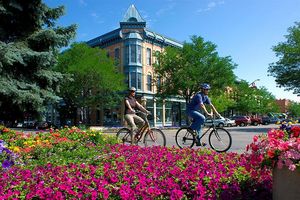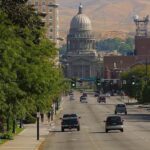This article is the sixth in a 50-state series: it lists the largest cities, towns, and CDPs (hereinafter “cities”) in Colorado by population size and provides demographic details for each city–total population, population by age group, racial composition of the population, land area, and population density.
The data in this article was updated to include the latest 1, 3, and 5-year population estimates from the United States Census Bureau where available.
After reading “Largest Cities in Colorado (2011),” return to this link to read “Best Places to Live in Colorado (2011).”
Similar articles for the remaining 49 states can be found at these links: Alabama, Alaska, Arizona, Arkansas, California, Connecticut, Delaware, Florida, Georgia, Hawaii, Idaho, Illinois, Indiana, Iowa, Kansas, Kentucky, Louisiana, Maine, Maryland, Massachusetts, Michigan, Minnesota, Missouri, Mississippi, Montana, Nebraska, Nevada, New Hampshire, New Jersey, New Mexico, New York, North Carolina, North Dakota, Ohio, Oklahoma, Oregon, Pennsylvania, Rhode Island, South Carolina, South Dakota, Tennessee, Texas, Utah, Vermont, Virginia, Washington, West Virginia, Wisconsin, and Wyoming.
1. Largest Cities in Colorado (2011) : Denver, CO
Located in the northern part of central Colorado, Denver is the state’s capital and largest city with an estimated population of 610,345.
Grouped by age, 24.4% of the population is under 18, 8.0% is 18 to 24, 34% is 25 to 44, 23.2% is 45 to 64, and 10.4% is 65 or older. The median age of the population is 35.3.
The racial composition of the city is 74.1% White, 9.6% Black or African American, 1.1% Native American, 3.3% Asian, 0.1% Pacific Islander, 9.2% from other races, and 2.5% from two or more races. The population is 34.1% Hispanic or Latino of any race.
The land area of the city is 153.35 square miles. The city’s population density is 3,980.08 people per square mile.
2. Largest Cities in Colorado (2011): Colorado Springs, CO
Situated in central Colorado, Colorado Springs is the second largest city in the state with an estimated population of 399,803.
Classified by age, 25.4% of the population is under 18, 9.1% is 18 to 24, 30.5% is 25 to 44, 25.0% is 45 to 64, and 10.0% is 65 or older. The median age of the population is 34.7.
The racial complexion of the city is 79.3% White, 6.6% Black or African American, 0.8% Native American, 2.9% Asian, 0.2% Pacific Islander, 5.6% from other races, and 4.6% from two or more races. The population is 14.6% Hispanic or Latino of any race.
The land area of the city is 185.74 square miles. The city’s population density is 2,152.49 people per square mile.
3. Largest Cities in Colorado (2011): Aurora, CO
Located in the northern part of central Colorado, Aurora is the third largest city in the state with an estimated population of 323,288.
Categorized by age, 26.8% of the population is under 18, 8.9% is 18 to 24, 31.2% is 25 to 44, 24.2% is 45 to 64, and 8.9% is 65 or older. The median age of the population is 33.7.
The racial profile of the city is 68.4% White, 14.6% Black or African American, 0.7% Native American, 4.8% Asian, 0.3% Pacific Islander, 8.1% from other races, and 3.0% from two or more races. The population is 27.1% Hispanic or Latino of any race.
The land area of the city is 142.50 square miles. The city’s population density is 2,268.69 people per square mile.
4. Largest Cities in Colorado (2011): Lakewood, CO
Situated in the northern part of central Colorado, Lakewood is the fourth largest city in the state with an estimated population of 141,928.
Sorted by age, 20.4% of the population is under 18, 10.2% is 18 to 24, 27.7% is 25 to 44, 27.8% is 45 to 64, and 13.9% is 65 or older. The median age of the population is 38.8.
The racial makeup of the city is 83.4% White, 2.2% Black or African American, 0.9% Native American, 3.7% Asian, 0.1% Pacific Islander, 7.5% from other races, and 2.2% from two or more races. The population is 20.3% Hispanic or Latino of any race.
The land area of the city is 41.59 square miles. The city’s population density is 3,412.55 people per square mile.
5. Largest Cities in Colorado (2011): Fort Collins, CO
Located in the central part of northern Colorado, Fort Collins is the fifth largest city in the state with an estimated population of 138,722.
A comparatively large part of the population is college-aged: the city is home to Colorado State University. Arranged by age, 20.1% of the population is under 18, 20.8% is 18 to 24, 31.1% is 25 to 44, 20.2% is 45 to 64, and 7.8% is 65 or older. The median age of the population is 29.1.
The racial mix of the city is 89.1% White, 1.1% Black or African American, 0.5% Native American, 2.8% Asian, 2.8% from other races, and 3.7% from two or more races. The population is 9.3% Hispanic or Latino of any race.
The land area of the city is 46.54 square miles. The city’s population density is 2,980.70 people per square mile.
6. Largest Cities in Colorado (2011): Thornton, CO
Located in the northern part of central Colorado, Thornton is the sixth largest city in the state with an estimated population of 117,636.
Grouped by age, 24.5% of the population is under 18, 6.4% is 18 to 24, 34.4% is 25 to 44, 22.1% is 45 to 64, and 12.6% is 65 or older. The median age of the population is 31.7.
The racial composition of the city is 79.2% White, 1.3% Black or African American, 1.1% Native American, 3.8% Asian, 10.5% from other races, and 4.1% from two or more races. The population is 29.0% Hispanic or Latino of any race.
The land area of the city is 26.86 square miles. The city’s population density is 4,379.60 people per square mile.
7. Largest Cities in Colorado (2011): Westminster, CO
Located in the northern part of central Colorado, Westminster is the seventh largest city in the state with an estimated population of 109,173.
Grouped by age, 26.4% of the population is under 18, 9.4% is 18 to 24, 30.1% is 25 to 44, 26.1% is 45 to 64, and 8.0% is 65 or older. The median age of the population is 34.4.
The racial composition of the city is 82.8% White, 1.3% Black or African American, 0.7% Native American, 5.4% Asian, 0.1% Pacific Islander, 6.1% from other races, and 3.5% from two or more races. The population is 18.6% Hispanic or Latino of any race.
The land area of the city is 31.51 square miles. The city’s population density is 3,464.71 people per square mile.
8. Largest Cities in Colorado (2011): Arvada, CO
Located in the northern part of central Colorado, Arvada is the eighth largest city in the state with an estimated population of 108,165.
Grouped by age, 23.8% of the population is under 18, 8.8% is 18 to 24, 26.8% is 25 to 44, 23.1% is 45 to 64, and 15.6% is 65 or older. The median age of the population is 35.7.
The racial composition of the city is 80.8% White, 2.7% Black or African American, 2.0% Native American, 0.6% Asian, 10.5% from other races, and 3.5% from two or more races. The population is 45.9% Hispanic or Latino of any race.
The land area of the city is 45.08 square miles. The city’s population density is 2,399.40 people per square mile.
9. Largest Cities in Colorado (2011): Pueblo, CO
Located in the southeastern part of central Colorado, Pueblo is the ninth largest city in the state with an estimated population of 104,875.
Grouped by age, 24.0% of the population is under 18, 10.5% is 18 to 24, 26.8% is 25 to 44, 23.1% is 45 to 64, and 15.6% is 65 or older. The median age of the population is 35.7.
The racial composition of the city is 80.8% White, 2.7% Black or African American, 2.0% Native American, 0.6% Asian, 10.5% from other races, and 3.5% from two or more races. The population is 45.9% Hispanic or Latino of any race.
The land area of the city is 45.08 square miles. The city’s population density is 2,326.42 people per square mile.
10. Largest Cities in Colorado (2011): Centennial, CO
Located in the northern part of central Colorado, Centennial is the tenth largest city in the state with an estimated population of 100,556.
Grouped by age, 23.5% of the population is under 18, 8.3% is 18 to 24, 22.3% is 25 to 44, 34.5% is 45 to 64, and 11.4% is 65 or older. The median age of the population is 37.2.
The racial composition of the city is 85.2% White, 5.0% Black or African American, 0.4% Native American, 4.6% Asian, 0.8% Pacific Islander, 1.5% from other races, and 2.5% from two or more races. The population is 4.8% Hispanic or Latino of any race.
The land area of the city is 28.24 square miles. The city’s population density is 3,560.76 people per square mile.
11. Largest Cities in Colorado (2011): Boulder, CO
Located in the northern part of central Colorado, Boulder is the eleventh largest city in the state with an estimated population of 100,160.
An unusually large part of the population is college-aged: the city is home to the University of Colorado. Grouped by age, 13.4% of the population is under 18, 27.3% is 18 to 24, 30% is 25 to 44, 21.3% is 45 to 64, and 8.0% is 65 or older. The median age of the population is 29.4.
The racial composition of the city is 88.0% White, 0.8% Black or African American, 0.4% Native American, 4.5% Asian, 0.1% Pacific Islander, 4.1% from other races, and 2.1% from two or more races. The population is 8.5% Hispanic or Latino of any race.
The land area of the city is 24.37 square miles. The city’s population density is 4,109.97 people per square mile.
12. Largest Cities in Colorado (2011): Highlands Ranch, CO
Located in central Colorado, Highlands Ranch is the twelfth largest city in the state with an estimated population of 99,760.
Grouped by age, 31.3% of the population is under 18, 6.2% is 18 to 24, 35.2% is 25 to 44, 22.7% is 45 to 64, and 4.6% is 65 or older. The median age of the population is 33.
The racial composition of the city is 88.7% White, 1.3% Black or African American, 0.3% Native American, 5.2% Asian, 2.1% from other races, and 2.5% from two or more races. The population is 6.4% Hispanic or Latino of any race.
The land area of the city is 23.52 square miles. The city’s population density is 4,241.50 people per square mile.
13. Largest Cities in Colorado (2011): Greeley, CO
Located in the central part of northern Colorado, Greeley is the thirteenth largest city in the state with an estimated population of 92,621.
A relatively large part of the population is college-aged: the city is home to University of Northern Colorado. Grouped by age, 23.5% of the population is under 18, 19.3% is 18 to 24, 28.2% is 25 to 44, 19.4% is 45 to 64, and 9.6% is 65 or older. The median age of the population is 28.3.
The racial composition of the city is 84.5% White, 1.2% Black or African American, 0.7% Native American, 1.9% Asian, 0.1% Pacific Islander, 9.6% from other races, and 2.1% from two or more races. The population is 33.9% Hispanic or Latino of any race.
The land area of the city is 29.9 square miles. The city’s population density is 3,097.69 people per square mile.
14. Largest Cities in Colorado (2011): Longmont, CO
Located in the northern part of central Colorado, Longmont is the fourteenth largest city in the state with an estimated population of 88,369.
Grouped by age, 26.8% of the population is under 18, 7.7% is 18 to 24, 30.2% is 25 to 44, 26.2% is 45 to 64, and 9.1% is 65 or older. The median age of the population is 35.3.
The racial composition of the city is 82.4% White, 1.1% Black or African American, 0.5% Native American, 2.8% Asian, 10.6% from other races, and 2.5% from two or more races. The population is 24.6% Hispanic or Latino of any race.
The land area of the city is 21.79 square miles. The city’s population density is 4,055.48 people per square mile.
15. Largest Cities in Colorado (2011): Loveland, CO
Located in the central part of northern Colorado, Loveland is the fifteenth largest city in the state with an estimated population of 66,213.
Grouped by age, 24.4% of the population is under 18, 8.1% is 18 to 24, 29.4% is 25 to 44, 25.4% is 45 to 64, and 12.7% is 65 or older. The median age of the population is 36.3.
The racial composition of the city is 92.9% White, 0.7% Black or African American, 0.8% Native American, 0.7% Asian, 2.8% from other races, and 2.1% from two or more races. The population is 11.9% Hispanic or Latino of any race.
The land area of the city is 24.57 square miles. The city’s population density is 2,694.87 people per square mile.
16. Largest Cities in Colorado (2011): Grand Junction, CO
Located in the central part of western Colorado, Grand Junction is the sixteenth largest city in the state with an estimated population of 56,630.
Grouped by age, 20.3% of the population is under 18, 12.5% is 18 to 24, 26.1% is 25 to 44, 24.3% is 45 to 64, and 16.8% is 65 or older. The median age of the population is 37.2.
The racial composition of the city is 88.2% White, 1.0% Black or African American, 0.8% Native American, 0.9% Asian, 6.9% from other races, and 2.2% from two or more races. The population is 13.9% Hispanic or Latino of any race.
The land area of the city is 30.81 square miles. The city’s population density is 1,838.04 people per square mile.
17. Largest Cities in Colorado (2011): Broomfield, CO
Located in the northern part of central Colorado, Broomfield is the seventeenth largest city in the state with an estimated population of 54,822.
Grouped by age, 26.3% of the population is under 18, 9.2% is 18 to 24, 32.2% is 25 to 44, 25.4% is 45 to 64, and 6.9% is 65 or older. The median age of the population is 34.4.
The racial composition of the city is 88.4% White, 0.8% Black or African American, 0.2% Native American, 4.2% Asian, 2.8% from other races, and 3.5% from two or more races. The population is 11.4% Hispanic or Latino of any race.
The land area of the city is 27.11 square miles. The city’s population density is 2,022.21 people per square mile.
18. Largest Cities in Colorado (2011): Castle Rock, CO
Located in central Colorado, Castle Rock is the eighteenth largest city in the state with an estimated population of 44,117.
Grouped by age, 29.3% of the population is under 18, 8.5% is 18 to 24, 36.4% is 25 to 44, 21.2% is 45 to 64, and 4.6% is 65 or older. The median age of the population is 31.2.
The racial composition of the city is 92.4% White, 1.2% Black or African American, 0.8% Native American, 1.9% Asian, 0.3% Pacific Islander, 1.4% from other races, and 2.0% from two or more races. The population is 9.1% Hispanic or Latino of any race.
The land area of the city is 31.61 square miles. The city’s population density is 1,395.67 people per square mile.
19. Largest Cities in Colorado (2011): Commerce City, CO
Located in the northern part of central Colorado, Commerce City is the nineteenth largest city in the state with an estimated population of 42,406.
Grouped by age, 31.3% of the population is under 18, 6.2% is 18 to 24, 39.0% is 25 to 44, 17.8% is 45 to 64, and 5.7% is 65 or older. The median age of the population is 29.4.
The racial composition of the city is 78.6% White, 2.6% Black or African American, 0.5% Native American, 2.4% Asian, 12.6% from other races, and 3.3% from two or more races. The population is 51.0% Hispanic or Latino of any race.
The land area of the city is 25.84 square miles. The city’s population density is 1,641.10 people per square mile.
20. Largest Cities in Colorado (2011): Littleton, CO
Located in the northern part of central Colorado, Littleton is the twentieth largest city in the state with an estimated population of 42,355.
Grouped by age, 21.0% of the population is under 18, 9.8% is 18 to 24, 23.2% is 25 to 44, 29.5% is 45 to 64, and 16.5% is 65 or older. The median age of the population is 41.7.
The racial composition of the city is 90.7% White, 1.8% Black or African American, 0.6% Native American, 3.0% Asian, 2.5% from other races, and 1.3% from two or more races. The population is 11.3% Hispanic or Latino of any race.
The land area of the city is 13.52 square miles. The city’s population density is 3,132.77 people per square mile.
More Articles from J.C. Grant :
“Average ACT Scores by State (2010)”
“Average SAT Scores by State (2010)”
“Largest U.S. Cities: Population Size (2011)”
“Most_Dangerous_Cities in America – Murder Rates”
State Education Rankings: Graduation Rates for High School, College, and Grad/Professional School
“State Education Rankings: SAT Scores”
Source(s):
“Population, Housing Units, Area, and Density: 2000,” U.S. Census Bureau
“2009 ACS 1-year Estimates,” U.S. Census Bureau
“2007-2009 ACS 3-year Estimates,” U.S. Census Bureau
“2006-2008 ACS 3-year Estimates,” U.S. Census Bureau
“2005-2009 ACS 5-Year Estimates,” U.S. Census Bureau








